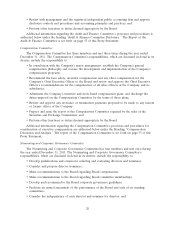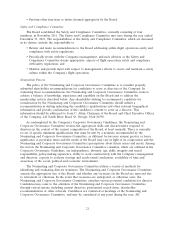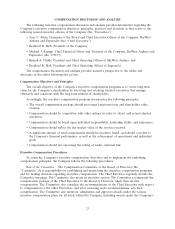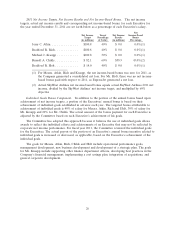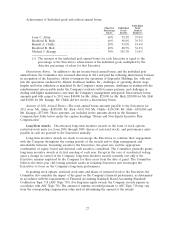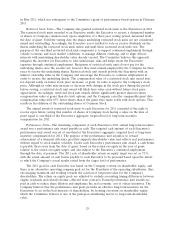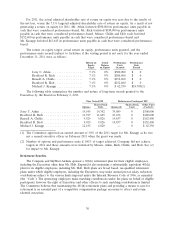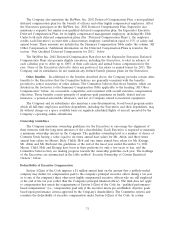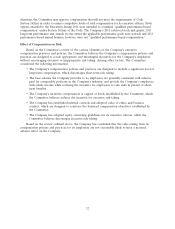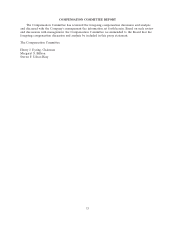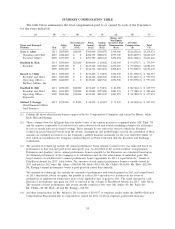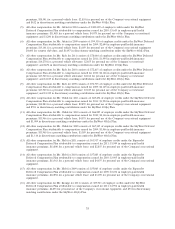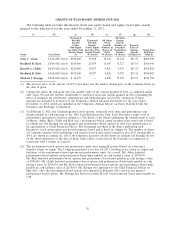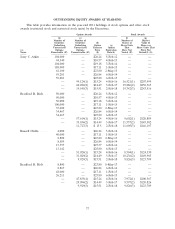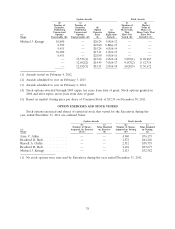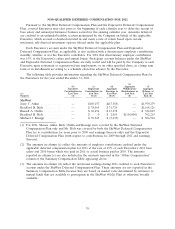SkyWest Airlines 2011 Annual Report Download - page 140
Download and view the complete annual report
Please find page 140 of the 2011 SkyWest Airlines annual report below. You can navigate through the pages in the report by either clicking on the pages listed below, or by using the keyword search tool below to find specific information within the annual report.in May 2011, which was subsequent to the Committee’s grant of performance-based options in February
2011.
Restricted Stock Units—The Company also granted restricted stock units to the Executives in 2011.
The restricted stock units awarded to an Executive entitle the Executive to receive a designated number
of shares of Company common stock upon completion of a three-year vesting period, measured from
the date of grant. Until the vesting date the shares underlying restricted stock units are not considered
issued and outstanding. Accordingly, the Executive is not entitled to vote or receive dividends on the
shares underlying his restricted stock units unless and until those restricted stock units vest. The
purpose of the one-third restricted stock unit component is to support continued employment through
volatile economic and stock market conditions, to manage dilution overhang, and to align officers’
interests with maintaining shareholder value already created. The Committee believes this approach
mitigates the incentive for Executives to take unnecessary risks and helps retain the Executives’
expertise through continued employment. Recipients of restricted stock units do not pay for the
underlying shares once the awards vest; however they must remain employed by the Company for three
years to receive the underlying shares. Restricted stock unit awards provide the Executives with an
indirect ownership stake in the Company and encourage the Executive to continue employment in
order to receive the underlying shares. The compensation value of a restricted stock unit award does
not depend solely on future stock price increases; at grant, its value is equal to the Company’s stock
price. Although its value may increase or decrease with changes in the stock price during the period
before vesting, a restricted stock unit award will likely have value even without future stock price
appreciation. Accordingly, restricted stock unit awards deliver significantly greater share-for-share
compensation value at grant than do stock options, and the Company can offer comparable grant date
compensation value with 65% fewer shares than if the grant were made solely with stock options. This
results in less dilution of the outstanding shares of Common Stock.
The annual award of restricted stock units to each Executive for 2011 consisted of the right to
receive upon future vesting that number of shares of Company stock having a value on the date of
grant equal to one-third of the Executive’s aggregate, targeted level of long-term incentive
compensation for 2011.
Performance Units—The remaining component of each Executive’s 2011 annual long-term incentive
award was a performance unit award payable in cash. The targeted cash amount of each Executive’s
performance unit award was set at one-third of the Executive’s aggregate, targeted level of long-term
incentive compensation for 2011. The purpose of the performance unit awards is to reward
achievement of a financial efficiency goal that supports shareholder value and reflects real performance
without regard to stock market volatility. Under each Executive’s performance unit award, a cash bonus
is payable three years from the date of grant, based on the return on equity in the year of grant,
relative to the return on equity target, and also subject to the Executive’s continued employment
through the date of payment. The 2011 rate of shareholder return on equity target was set as 7.1%,
with the actual amount of cash bonus payable to each Executive to be prorated based upon the extent
to which the Company’s actual results varied from the target level of performance.
The 2011 goal for each Executive was based on the Company’s return on shareholder equity, and
there is no alternative operating company goal set for the Presidents of the operating subsidiaries, thus
encouraging teamwork and working towards the creation of long-term value for the Company’s
shareholders. The return on equity goals are adjusted to exclude accounting timing differences between
engine overhauls and related revenue collected from contracts. Earned performance unit awards are
paid in cash to reduce share dilution and emphasize the real economic cost of officer incentives. The
Company believes that the performance unit grant provides an effective long-term incentive for the
Executives to act in the best interests of shareholders, by focusing on return on shareholder equity,
which the Committee believes is one of the principal contributing factors to long-term shareholder
value.
29



